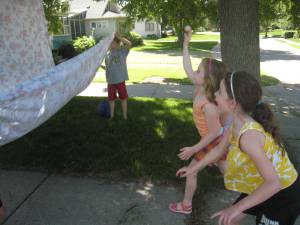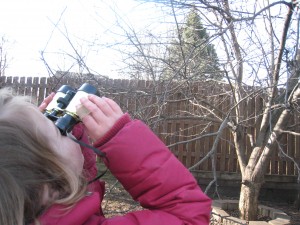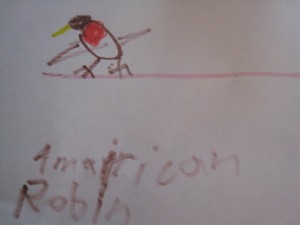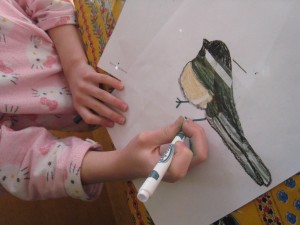Tag: backyard’
Backyard Physics- Throwing Eggs
- by KitchenPantryScientist
It’s getting nice outside. Time to start thinking about backyard science! Here’s one of our favorites, if you haven’t already tried it! W

“Kids aren’t getting dirty these days. They’re not playing in the mud, not playing in rain puddles,” says Dr. Truglio, of Sesame Workshop in a Wall Street Journal article, about getting your kids outside.
Next to the kitchen table, my back yard (or front yard) is my favorite science laboratory. It has the added bonus of being easy to clean up. For this fun, messy experiment, a hose and a few paper towels do the trick. Make your kids clean up whatever mess they make!
My dad, who is a physicist, told me about this great demonstration. It teaches kids a little bit about motion and force while letting them do something that they are rarely, if ever, allowed to do- throw eggs! All you need is a sheet, some clothespins or string, raw eggs, and some paper. (You could use newspaper or easel paper. It is just to make cleaning up easier.) I also used a portable table turned on its side as a wall, but you could just use a wall or the side of a garage and have your child hose it off when you are finished.
Hang the sheet up from a tree, if you have one. If you don’t have a tree, you could hang it from anything else, or have two tall children or adults hold it. Then have two kids hold the bottom of the sheet up, or tie it to chairs so it makes a J shape when you view it from the side. The idea is to keep the eggs from hitting the ground and breaking.

An object in motion wants to remain in motion. To stop an egg moving through the air, you have to apply force to the egg. In this case, the force will be applied by a hanging sheet, or a wall.
Throw a raw egg at the sheet as hard as you can. It won’t break because the sheet slows the movement of the egg as it comes to a stop. The law of motion says that the faster you change the speed of an object, the greater the force applied to the object will be. When you change the speed of the egg slowly, like the sheet does, it lessens the force applied to the egg and the egg remains intact.
Now, put some paper on a wall (or table like we did.) Throw an egg at the wall. You’ll see what happens when something stops fast. Once again, the law of motion rules. When you change the speed of the egg quickly, it stops with a lot of force. SPLAT. This is my kids’ favorite part.

This is why they put airbags in cars. If a car is moving and hits something, causing it to stop very quickly, the airbag act like the sheet, slowing the person in the car down SLOWLY and greatly reducing the amount of force they might hit the dashboard with.
Record your results in your science notebook, if you want to. Finally, be sure to wash your hands when you’re finished experimenting and cleaning up. Raw eggs can have bacteria called Salmonella living in them and on them. Have fun!
Backyard Birding
- by KitchenPantryScientist
The weekend started off when I took our four-year old to see the movie “How to Train Your Dragon” (I think I liked it as much as she did) and left the theater talking about what it would be like to fly. We did a craft project, taking a butterfly from egg to wings, and toppped Sunday off by going for a bird-watching walk through the neighborhood and nearby woods.
With the arrival of spring in Minnesota, birds are everywhere! Cardinals are singing outside as I type. On our walk, we saw dozens of robins and woodpeckers. A hawk soared over and a nearby crow cawed at a Turkey Buzzard that soared down too close to his meal. I knew it was a buzzard because it was entirely black and I recognized the shape of its wingtips.
Do you know how to tell what kind of bird you’re looking at? The study of birds is called Ornithology and bird watching can be fun for all ages.
Why not go on a bird walk with your kids? Take a bird guide, if you have one, a notebook (their science notebook would be perfect) or a piece of paper and write down or draw what the birds you see look like. Binoculars would be great too, but aren’t necessary. Be sure to notice what color the birds you see are, special markings they might have, how big they are, and how their wings are shaped. You can even memorize or record how their song sounds. Do they sing “chick-a-dee-dee-dee” or “who-cooks-for-you?” If you feel like it, count how many robins or cardinals you see!
When you get home from your walk, you can use a Bird Identification book to look up your discoveries, or you can go online and use one of the many, interactive resources there. I decided to use whatbird.com and allaboutbirds.org from the Cornell Lab of Ornithology, to try to identify the hawk that we saw. Although I thought it was a red-tail hawk, I wasn’t sure. Both websites were helpful. Whatbird.com offered a visual search, where you could choose from different fields, like color and wing shape to narrow your identification. It worked pretty well, but didn’t seem foolproof. Allaboutbirds.org had a field where you could search birds by name and shape, which had nice photos you could use to identify what you had seen. Your kids could even make a guide of birds in your area!
So get those kids outside and let them hone their observations skills! No one offers a better show at a better price than Mother Nature!


